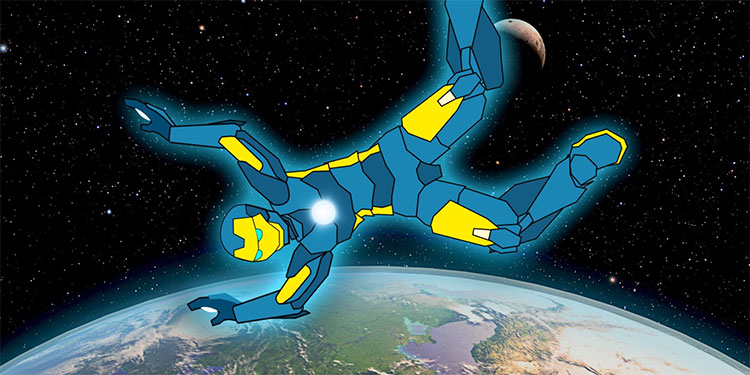What happens if parachuting from the International Space Station?
Most people parachute jump off the plane from a height of 3.8 km. But imagine you skydiving at a higher place, such as the International Space Station (ISS). Unless you have armor like Ironman, the results won't be very good. But imagine Ironman lending you the armor. Ok 1,2, 3 . dance! Wait . what is it?
That's right, you won't fall straight down. In fact, it will take you at least 2.5 years to touch the ground. So what's going on?
Altitude is not the main reason why you fall so long. If you fall like a regular skydiver, the jump lasts only about two hours. But the problem is you don't fall straight down. You fall into orbit. The cause is speed.
As you can see, ISS is called a station, but it hardly stands still. ISS station moves 12 times faster than jet fighters. If you shoot anything from that speed on Earth, before it falls to the ground, it will fly away. ISS station floats in the universe, it falls towards the Earth and flies away.

Falling through the atmosphere at such a great speed will put a lot of pressure on your armor.
When you jump off the ISS station, at first you fall at that speed, then you fall into orbit at least for a while. Although very high, the ISS station still flies through the very thin atmosphere. Friction caused the station to slow down. Therefore, the station must operate the engine to maintain speed and avoid crashing into the Earth.
Unfortunately, your armor is not attached to a leg motor. Two consequences will occur.
- First, you cannot manipulate and hope not to hit one of the 13,000 pieces of cosmic trash.
- Secondly, there is no missile to maintain speed, you will slow down and spiral down to Earth. But the fall will not be quick.
For example, China's Thien Cung 1 station takes about 2 years to fall from orbit. On the ISS station, you stay higher so it will take about 2.5 years. But the air reaches the atmosphere, your long waiting time will end.
When you return to the atmosphere, you have a goal of slowing down. You are moving at supersonic speed. So if you open it even now, the parachute will be ragged and it's not the only problem.
Falling through the atmosphere at such a great speed will put a lot of pressure on your armor. Acceleration force is at least 8G, 8 times the gravity at sea level. If your foot is facing the ground, the fall will cause your blood to flow from your brain to your feet. You may be unconscious, unless you are a combat pilot trained to withstand 5G acceleration.
If you are not unconscious, you may be concerned about the cold temperatures above. But your armor is more likely to melt than freeze. You know how to warm up by rubbing your hands together? Now imagine your armor rubbing with atmospheric gas at a rate of at least 6 times faster than the speed of sound. You will be heated to 1650 degrees Celsius, hot enough to melt iron.
This temperature is so hot that it separates the electron from the atom, forming a pink plasma around your body and destroying the armor. If that problem is not enough, traction will break your limbs, but the armor will help you to be intact.
41km from the ground, you will reach the highest parachute jump in the world. In 2014, Alan Eustace wore a pressurized suit when flying a balloon to this altitude. He broke the sound barrier when he jumped down, opened the umbrella, and grounded for about 15 minutes after the jump. But you will fall faster than Eustace, about 3 times the speed of sound. In fact, you won't fall slow enough to safely open the umbrella. That's when Ironman's armor will save you again.
At 1km above the ground, you have reached the normal height of the parachute. At this time, your parachute can be effective. Finally, it's time to land gently.
- Visit 'the longest road' on the ISS International Space Station
- How big is the International Space Station (ISS)?
- International space station increased altitude by 2km
- NASA opened the International Space Station for ... tourists and film makers from 2020
- Russian space station will replace the US ISS global surveillance
- The uncertain future of the ISS space station when NASA returns to the Moon
- Looking back at the ISS space station after 15 years of operation
- ISS International Space Station is about to end its historic mission
- The International Space Station is 15 years old
- The International Space Station lSS faces the risk of being abandoned
- International Space Station increased the orbit by 1.5km
- China plans to launch Tiangong Space Station similar to ISS by 2020
 Van Allen's belt and evidence that the Apollo 11 mission to the Moon was myth
Van Allen's belt and evidence that the Apollo 11 mission to the Moon was myth The levels of civilization in the universe (Kardashev scale)
The levels of civilization in the universe (Kardashev scale) Today Mars, the sun and the Earth are aligned
Today Mars, the sun and the Earth are aligned The Amazon owner announced a secret plan to build a space base for thousands of people
The Amazon owner announced a secret plan to build a space base for thousands of people